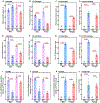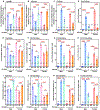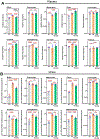Pantothenate kinase activation relieves coenzyme A sequestration and improves mitochondrial function in mice with propionic acidemia
- PMID: 34524863
- PMCID: PMC8830021
- DOI: 10.1126/scitranslmed.abf5965
Pantothenate kinase activation relieves coenzyme A sequestration and improves mitochondrial function in mice with propionic acidemia
Abstract
Propionic acidemia (PA) is a rare autosomal-recessive metabolic disease that arises from mutations in propionyl-CoA (C3-CoA) carboxylase. Reduced enzyme activity slows C3-CoA metabolism, leading to an elevated plasma C3:C2-carnitine ratio, the hallmark biomarker of PA. The metabolic imbalances experienced in PA are however poorly defined. Here, we used a hypomorphic PA mouse model to demonstrate that C3-CoA accumulation in liver reduced non-esterified CoA (CoASH) and acetyl-CoA (C2-CoA). Tricarboxylic acid (TCA) cycle intermediates that are normally metabolized instead accumulated in urine, providing direct evidence for compromised mitochondrial function in PA. Pantothenate kinase (PanK) is known to catalyze the rate-controlling step in CoA biosynthesis, and its inhibition by C3-CoA prevents an increase in CoA biosynthesis to alleviate CoASH sequestration. PZ-3022 is an allosteric PanK activator that counteracts C3-CoA inhibition. PZ-3022 therapy increased hepatic CoASH and C2-CoA and decreased C3-CoA in the PA mouse model, leading to improved intracellular C3:C2-CoA and plasma C3:C2-carnitine ratios. Elevated urinary malate is a major component of the metabolic signature for TCA cycle dysfunction in the PA mouse, and the 80% reduction in urine malate by PZ-3022 therapy indicates the restoration of mitochondrial function. Thus, CoASH sequestration in PA leads to reduced TCA cycle activity that is relieved by PZ-3022, providing preclinical proof of concept for PanK activators as a therapy to attenuate the underlying mitochondrial defect in PA.
Figures






Similar articles
-
Relief of CoA sequestration and restoration of mitochondrial function in a mouse model of propionic acidemia.J Inherit Metab Dis. 2023 Jan;46(1):28-42. doi: 10.1002/jimd.12570. Epub 2022 Nov 3. J Inherit Metab Dis. 2023. PMID: 36251252 Free PMC article.
-
Biochemical and anaplerotic applications of in vitro models of propionic acidemia and methylmalonic acidemia using patient-derived primary hepatocytes.Mol Genet Metab. 2020 Jul;130(3):183-196. doi: 10.1016/j.ymgme.2020.05.003. Epub 2020 May 11. Mol Genet Metab. 2020. PMID: 32451238 Free PMC article.
-
Propionyl-CoA carboxylase pcca-1 and pccb-1 gene deletions in Caenorhabditis elegans globally impair mitochondrial energy metabolism.J Inherit Metab Dis. 2018 Mar;41(2):157-168. doi: 10.1007/s10545-017-0111-x. Epub 2017 Nov 20. J Inherit Metab Dis. 2018. PMID: 29159707 Free PMC article.
-
Propionic acidemia in the Arab World.Gene. 2015 Jun 15;564(2):119-24. doi: 10.1016/j.gene.2015.04.019. Epub 2015 Apr 9. Gene. 2015. PMID: 25865301 Review.
-
Physiological roles of the pantothenate kinases.Biochem Soc Trans. 2014 Aug;42(4):1033-6. doi: 10.1042/BST20140096. Biochem Soc Trans. 2014. PMID: 25109998 Free PMC article. Review.
Cited by
-
Prevalence of propionic acidemia in China.Orphanet J Rare Dis. 2023 Sep 9;18(1):281. doi: 10.1186/s13023-023-02898-w. Orphanet J Rare Dis. 2023. PMID: 37689673 Free PMC article. Review.
-
Proton magnetic resonance spectroscopy detects cerebral metabolic derangement in a mouse model of brain coenzyme a deficiency.J Transl Med. 2022 Feb 23;20(1):103. doi: 10.1186/s12967-022-03304-y. J Transl Med. 2022. PMID: 35197056 Free PMC article.
-
Fasting alleviates metabolic alterations in mice with propionyl-CoA carboxylase deficiency due to Pcca mutation.Commun Biol. 2024 May 29;7(1):659. doi: 10.1038/s42003-024-06362-8. Commun Biol. 2024. PMID: 38811689 Free PMC article.
-
Relief of CoA sequestration and restoration of mitochondrial function in a mouse model of propionic acidemia.J Inherit Metab Dis. 2023 Jan;46(1):28-42. doi: 10.1002/jimd.12570. Epub 2022 Nov 3. J Inherit Metab Dis. 2023. PMID: 36251252 Free PMC article.
-
Acetyl-CoA biosynthesis drives resistance to histone acetyltransferase inhibition.Nat Chem Biol. 2023 Oct;19(10):1215-1222. doi: 10.1038/s41589-023-01320-7. Epub 2023 May 1. Nat Chem Biol. 2023. PMID: 37127754 Free PMC article.
References
-
- Baumgartner MR, Horster F, Dionisi-Vici C, Haliloglu G, Karall D, Chapman KA, Huemer M, Hochuli M, Assoun M, Ballhausen D, Burlina A, Fowler B, Grunert SC, Grunewald S, Honzik T, Merinero B, Perez-Cerda C, Scholl-Burgi S, Skovby F, Wijburg F, MacDonald A, Martinelli D, Sass JO, Valayannopoulos V, Chakrapani A, Proposed guidelines for the diagnosis and management of methylmalonic and propionic acidemia. Orphanet. J. Rare Dis 9, 130 (2014). - PMC - PubMed
-
- Clavero S, Martinez MA, Perez B, Perez-Cerda C, Ugarte M, Desviat LR, Functional characterization of PCCA mutations causing propionic acidemia. Biochim. Biophys. Acta 1588, 119–125 (2002). - PubMed
-
- Desviat LR, Perez B, Perez-Cerda C, Rodriguez-Pombo P, Clavero S, Ugarte M, Propionic acidemia: mutation update and functional and structural effects of the variant alleles. Mol. Genet. Metab 83, 28–37 (2004). - PubMed
-
- Al-Hamed MH, Imtiaz F, Al-Hassnan Z, Al-Owain M, Al-Zaidan H, Alamoudi MS, Faqeih E, Alfadhel M, Al-Asmari A, Saleh MM, Almutairi F, Moghrabi N, AlSayed M, Spectrum of mutations underlying propionic acidemia and further insight into a genotype-phenotype correlation for the common mutation in Saudi Arabia. Mol. Genet. Metab. Rep 18, 22–29 (2019). - PMC - PubMed
Publication types
MeSH terms
Substances
Grants and funding
LinkOut - more resources
Full Text Sources
Other Literature Sources
Miscellaneous

